
Promoting collaborative, pro-poor agricultural innovation
2003-2024

To design and implement innovative projects and programmes which
promote collaborative, pro-pooragricultural innovation, working in
partnership with other organizations and communities.
CbCCAand innovation system development: For sustainable livelihoods and climate resilience
To work at the cutting edge of development methodology and
processes, integrating learning(training), research and
implementation into new models and processes, emphasizing synergy
and integration.
Mission

Communal tenure, deep rural communities in KZN, EC and Limpopo:
Targetbeneficiaries
51 years, woman headed hh, Grade 9-11, unemployed, Ave
monthly income R2170, field cropping, gardening and livestock
husbandry, no access to water in hh, local markets only, savings
groups
!"#$%&'()(*+#,$-.#$/.+#0)&$,122-.+,#3$/#)(4$
$
$$
$
$
$
$
$
$
$
$
$
$
$
$
!"#$ %-/)#$ /#)(4$ +53+6-%#,$ %"#$ %&'()(*&$ 0(.$ #-6"$ (0$ %"#$ '-.%+6+'-5%,$ +5%#.7+#4#3$ 0(.$ %"#$ /-,#)+5#$
-,,#,,2#5%$
TypologyA- 49%
TypologyB– 27%
TypologyC– 24%
A good spread of different community members
involved in the Adaptation responses
Total
18-35 1
36-50 7
51-65 32
>65 10
17
32
10
No of respondents(50)
Farmer age categories
Fema
le,
78%
Male,
22%
Farmergender
Female
Male
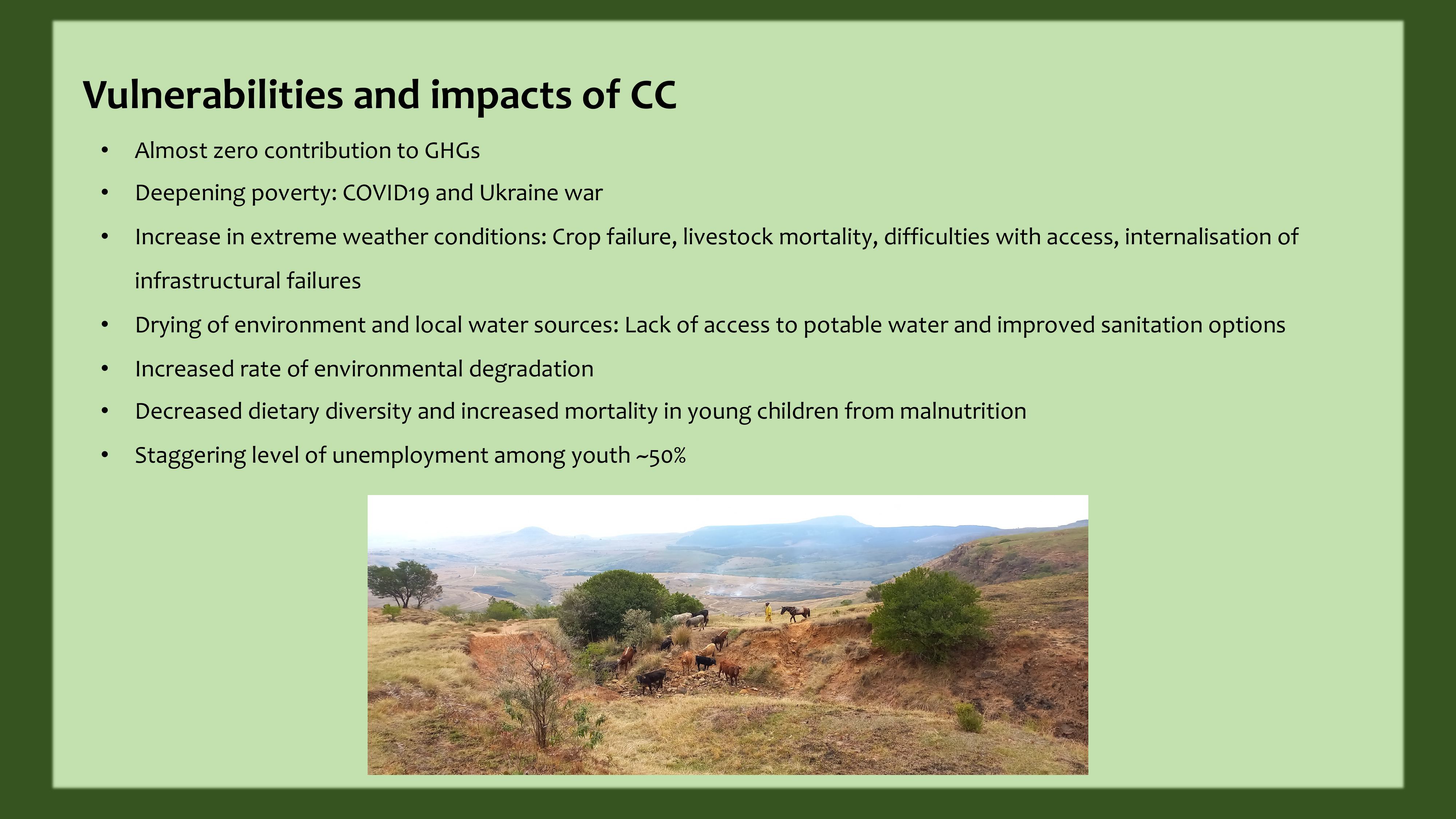
Vulnerabilities andimpactsof CC
•Almost zero contribution to GHGs
•Deepening poverty: COVID19 and Ukraine war
•Increase in extreme weather conditions: Crop failure, livestock mortality, difficulties with access, internalisation of
infrastructural failures
•Drying of environment and local water sources: Lack of access to potable water and improved sanitation options
•Increased rate of environmental degradation
•Decreased dietary diversity and increased mortality in young children from malnutrition
•Staggering level of unemployment among youth ~50%
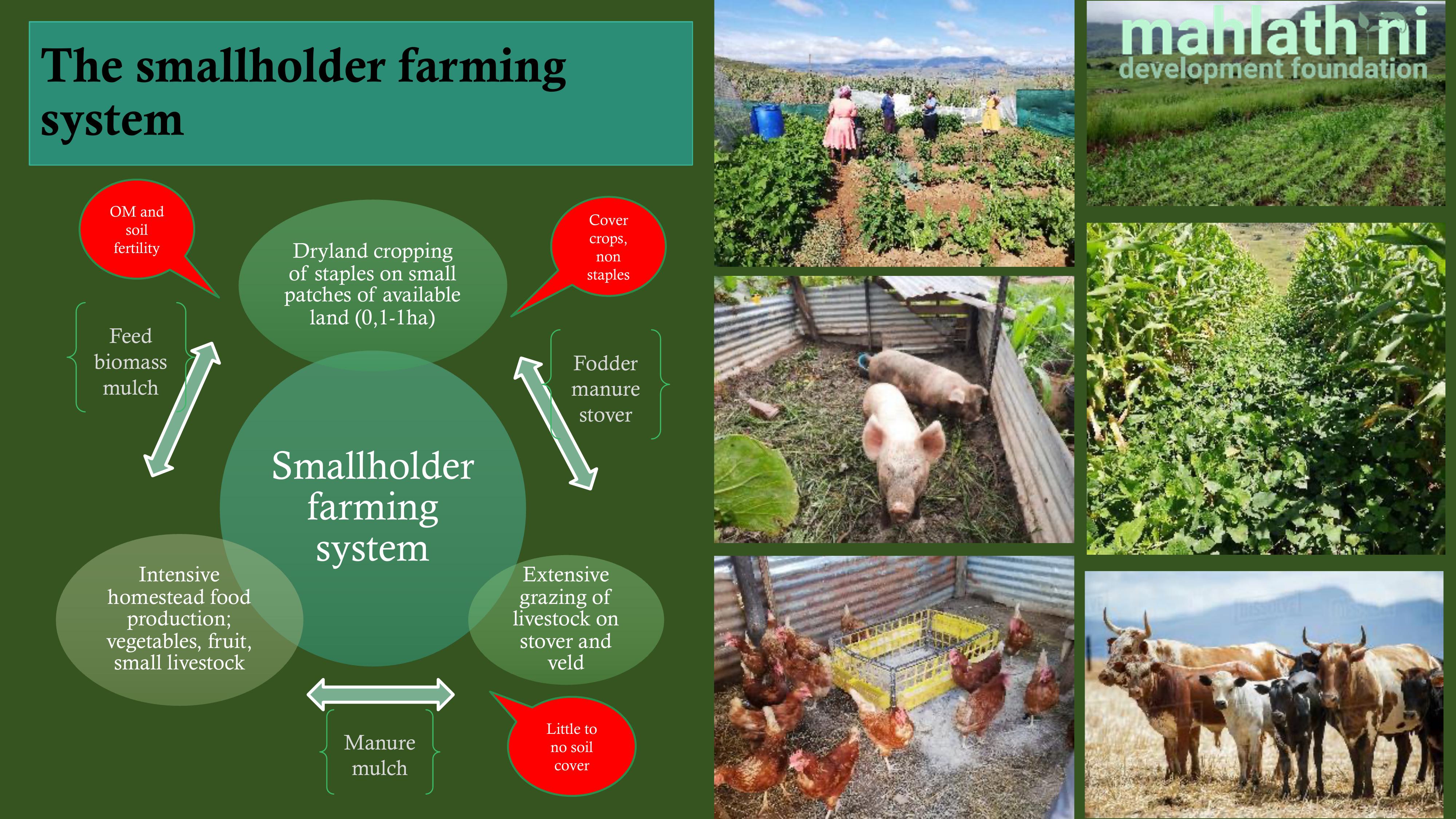
The smallholder farming
system
Smallholder
farming
system
Dryland cropping
of staples on small
patches of available
land (0,1-1ha)
Extensive
grazing of
livestock on
stover and
veld
Intensive
homestead food
production;
vegetables, fruit,
small livestock
Feed
biomass
mulch
Manure
mulch
Fodder
manure
stover
Cover
crops,
non
staples
OM and
soil
fertility
Little to
no soil
cover
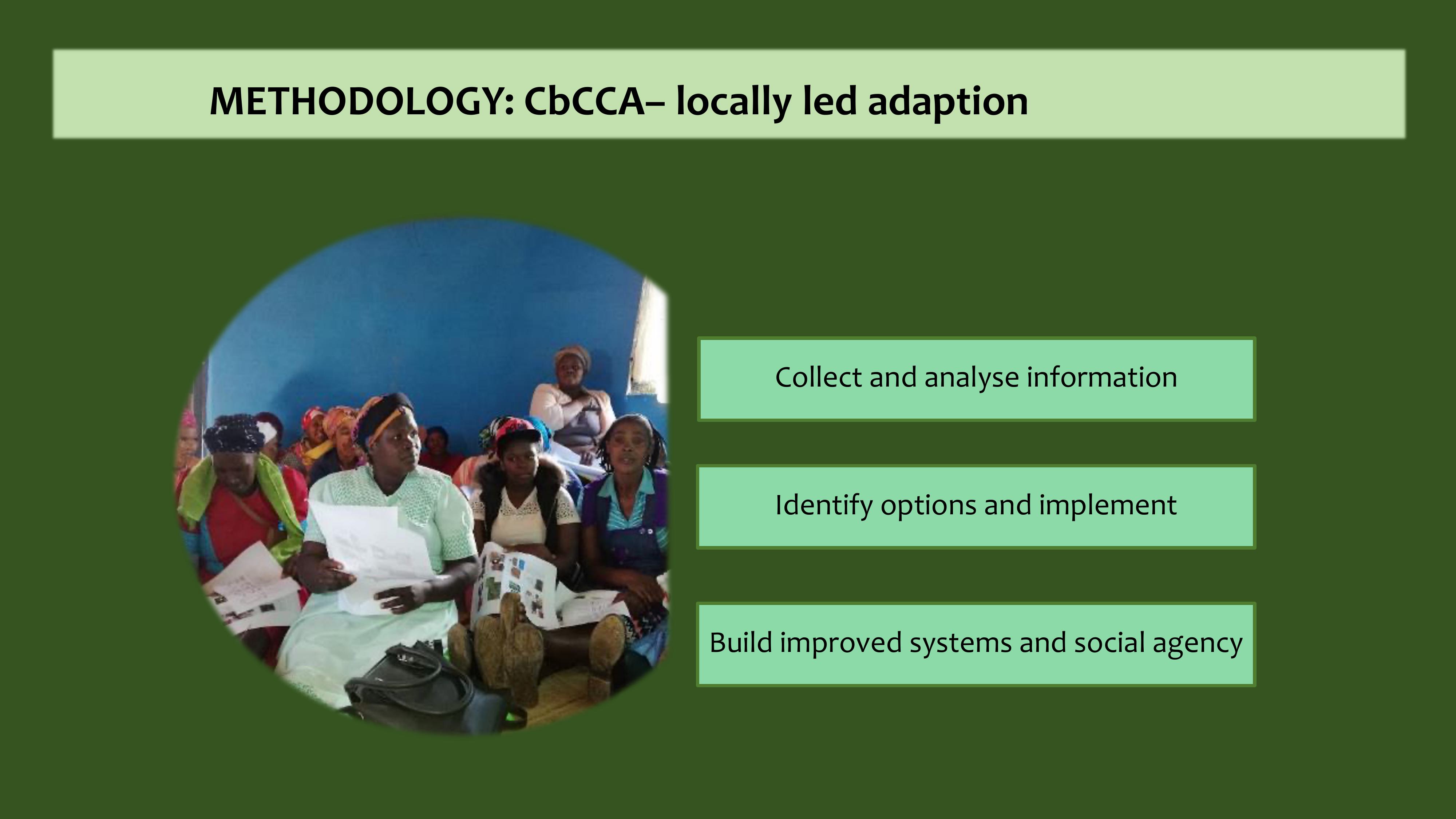
METHODOLOGY: CbCCA– locally led adaption
Identify options and implement
Build improved systems and social agency
Collect and analyse information
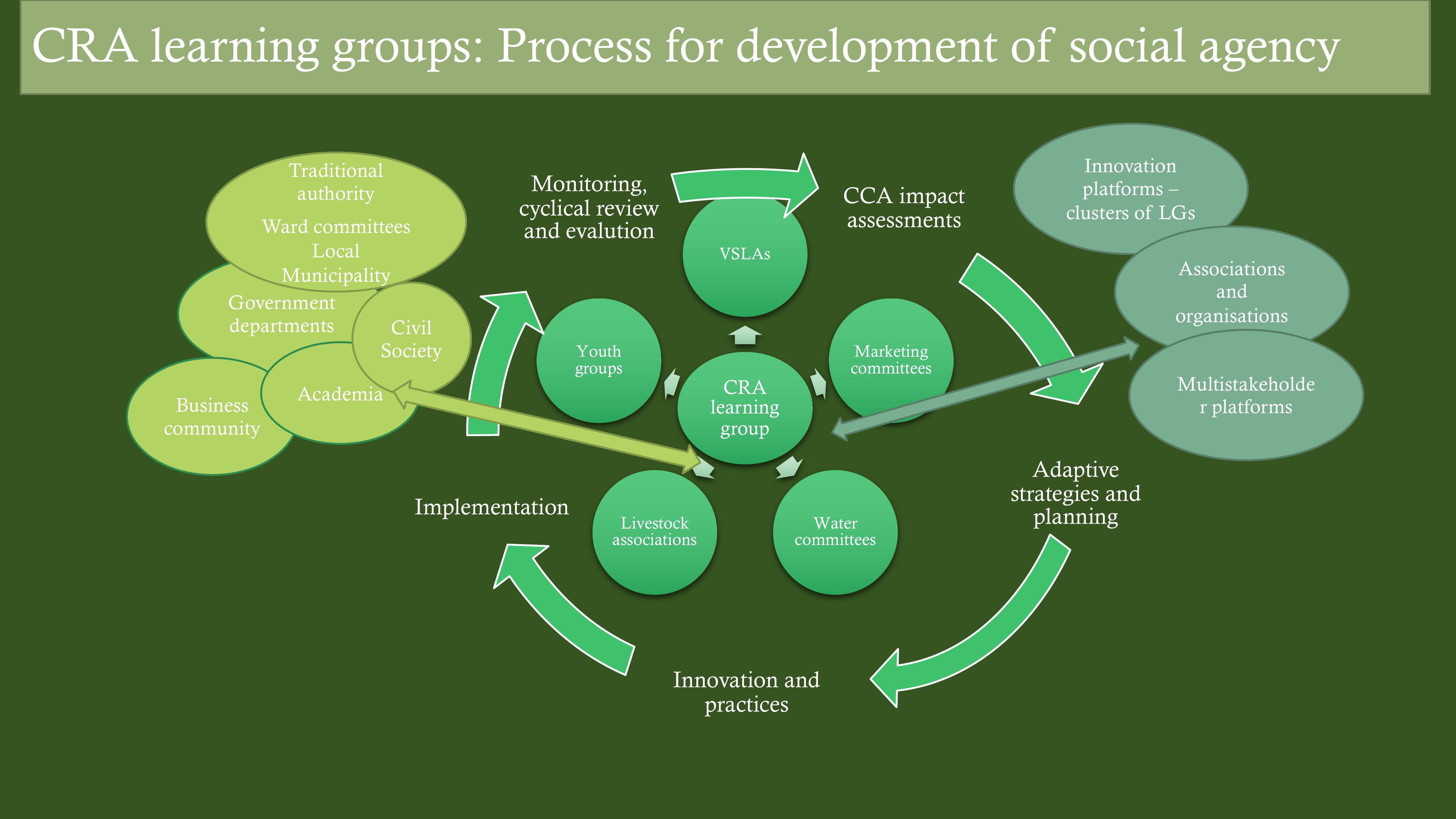
CRA
learning
group
VSLAs
Marketing
committees
Water
committees
Livestock
associations
Youth
groups
CCA impact
assessments
Adaptive
strategies and
planning
Innovation and
practices
Implementation
Monitoring,
cyclical review
and evalution
Government
departments
Traditional
authority
Wardcommittees
Local
Municipality
Business
community
Academia
Civil
Society
Innovation
platforms –
clusters of LGs
Associations
and
organisations
Multistakeholde
r platforms
CRA learning groups: Process for development of social agency
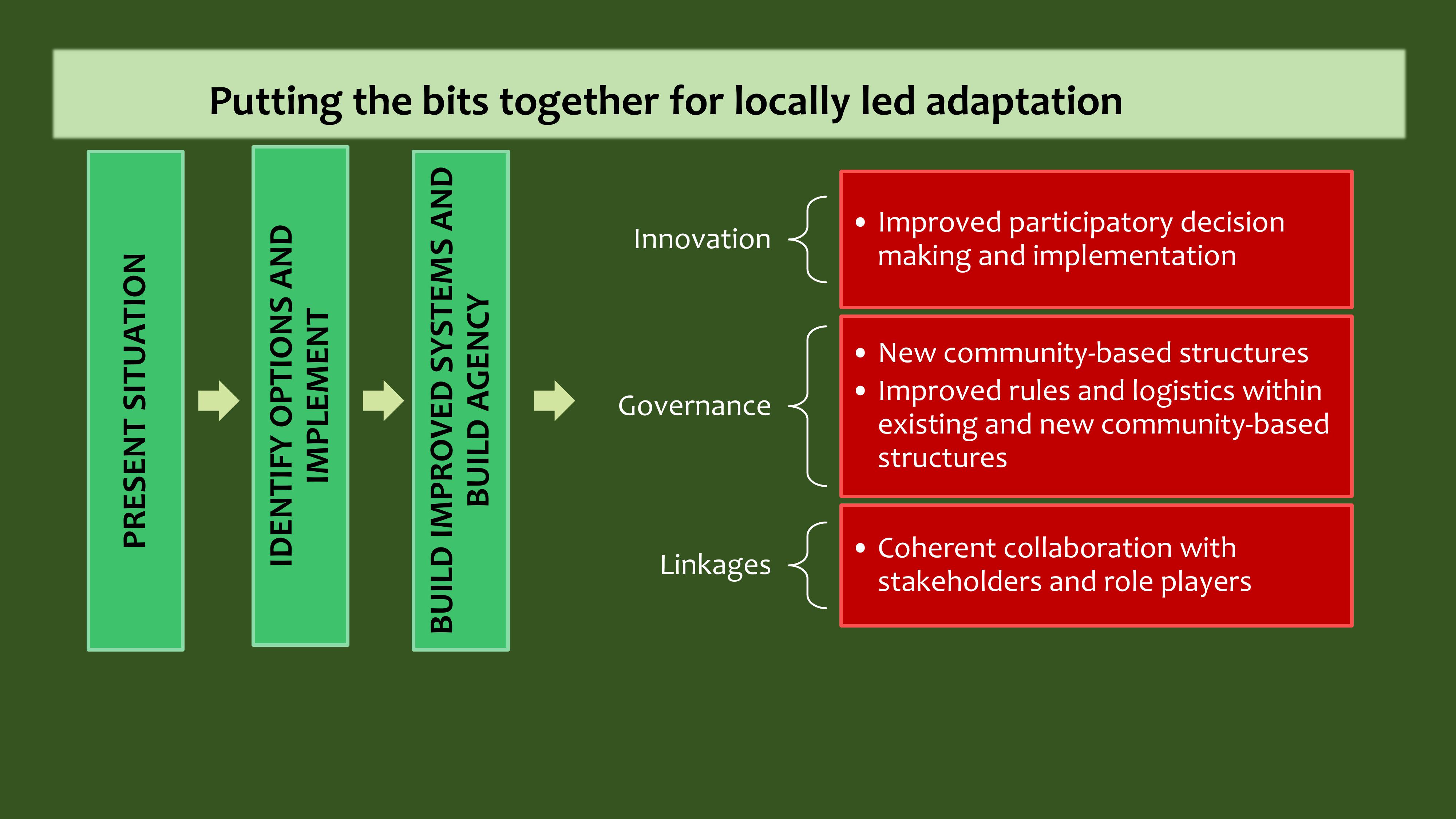
PRESENT SITUATION
IDENTIFY OPTIONS AND
IMPLEMENT
BUILD IMPROVED SYSTEMS AND
BUILD AGENCY
Innovation •Improved participatory decision
making and implementation
Governance
•New community-based structures
•Improved rules and logistics within
existing and new community-based
structures
Linkages •Coherent collaboration with
stakeholders and role players
Putting the bits together for locally led adaptation

EMERGENT ACTIVITY: Governance
•Social learningand knowledge co-creation
•Improved social agency for local resource
management; agreements, processes
•Community level improvement of
governance: individual, group, village,
and local stakeholder-based
Paradigms strongly commodity
focusedwithin agro-industrial
complex.
Implementationfor governance and
support virtually zero – Corruption
now almost completely systemic
The few actions undertaken are
oftencounterproductive
Context:
Institutional Governance
0
10
20
30
40
50
60
70
Community members
Homevisits
Learninggroups
Meetings
Phonecalls
Written info
Workshops
Organisations
Extensionofficers
Messages
Socialmedia
Radio
Demonstrations
Facilitators
Average % of farmers
Knowledge sharing methods and the average percentage of farmers using each
before and now
Before
Now

ACTIVITY: Climate Resilient Agriculture and innovation system
development for sustainable and productive use of land and water
•Conservation/ Regenerative Agriculture: (LEI) Quantitative research support to the Smallholder Farmer
Innovation Programme; intercropping, crop rotation, cover crops, fodder production
•Livestock integration: Winter fodder supplementation, hay baling, conservation agreements, local livestock auctions
•Intensive homestead food production: Agroecology; tunnels, trench beds, crop diversification, mulching,
greywater management, fruit production
•Food system elements: Nutrition enhancement of diets, value adding and seed saving
•Village savings and loan associations: for savings and small loans for productive activities
•Local marketing and food systems: Monthly produce market stalls organised per village, exploration of further
marketing options, small
mills for maize
48 villages in EC, KZN
and Limpopo
850 small holder
farmers
3500
beneficiaries
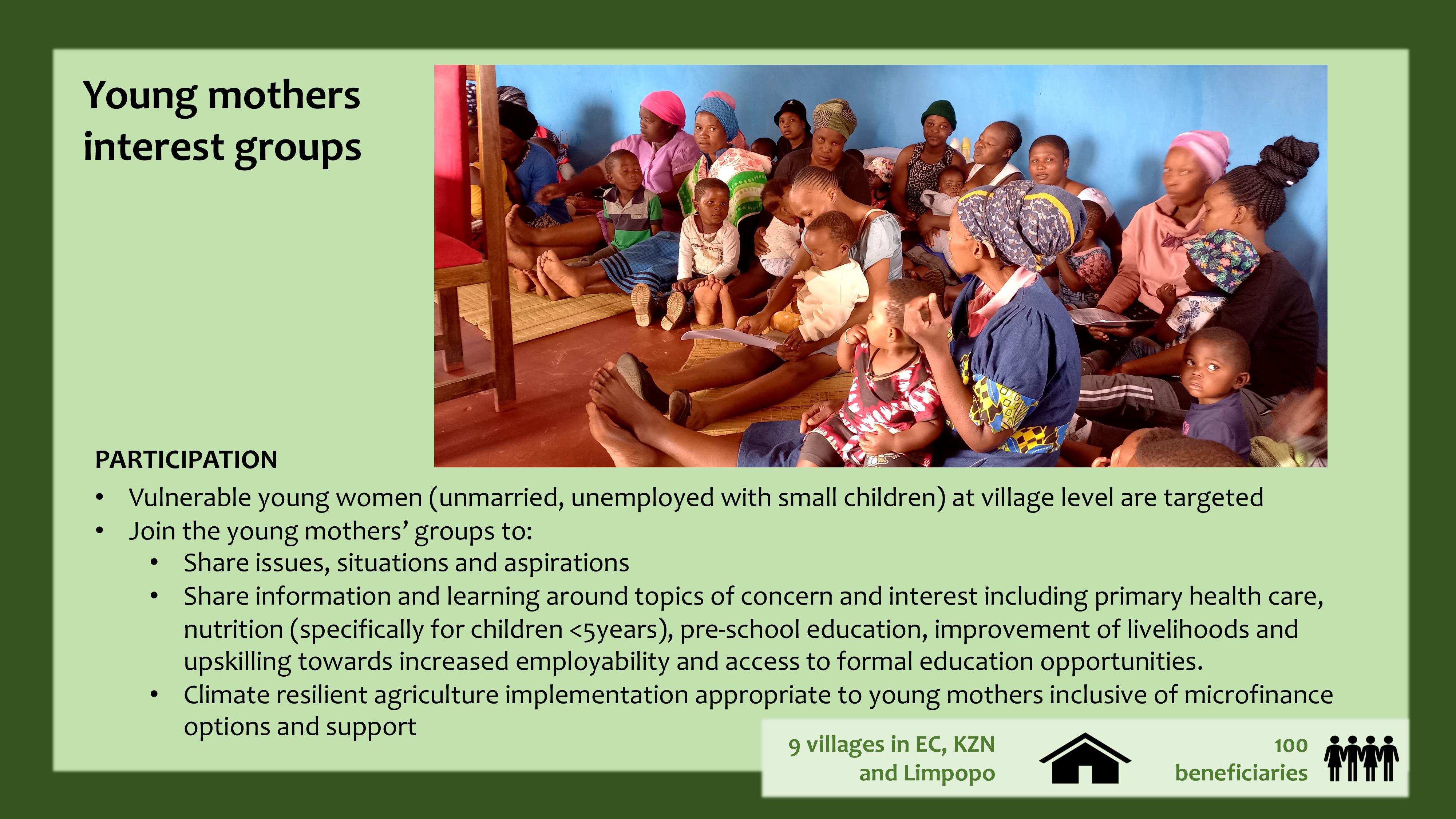
Youngmothers
interest groups
PARTICIPATION
•Vulnerable youngwomen(unmarried,unemployedwith smallchildren)atvillage levelaretargeted
•Join the young mothers’ groups to:
•Share issues, situations and aspirations
•Share information and learning around topics of concern and interest including primary health care,
nutrition (specifically for children <5years), pre-school education, improvement of livelihoods and
upskilling towards increased employability and access to formal education opportunities.
•Climate resilient agriculture implementation appropriate to young mothers inclusive of microfinance
options and support9 villages in EC, KZN
and Limpopo
100
beneficiaries

Conservation Agriculture
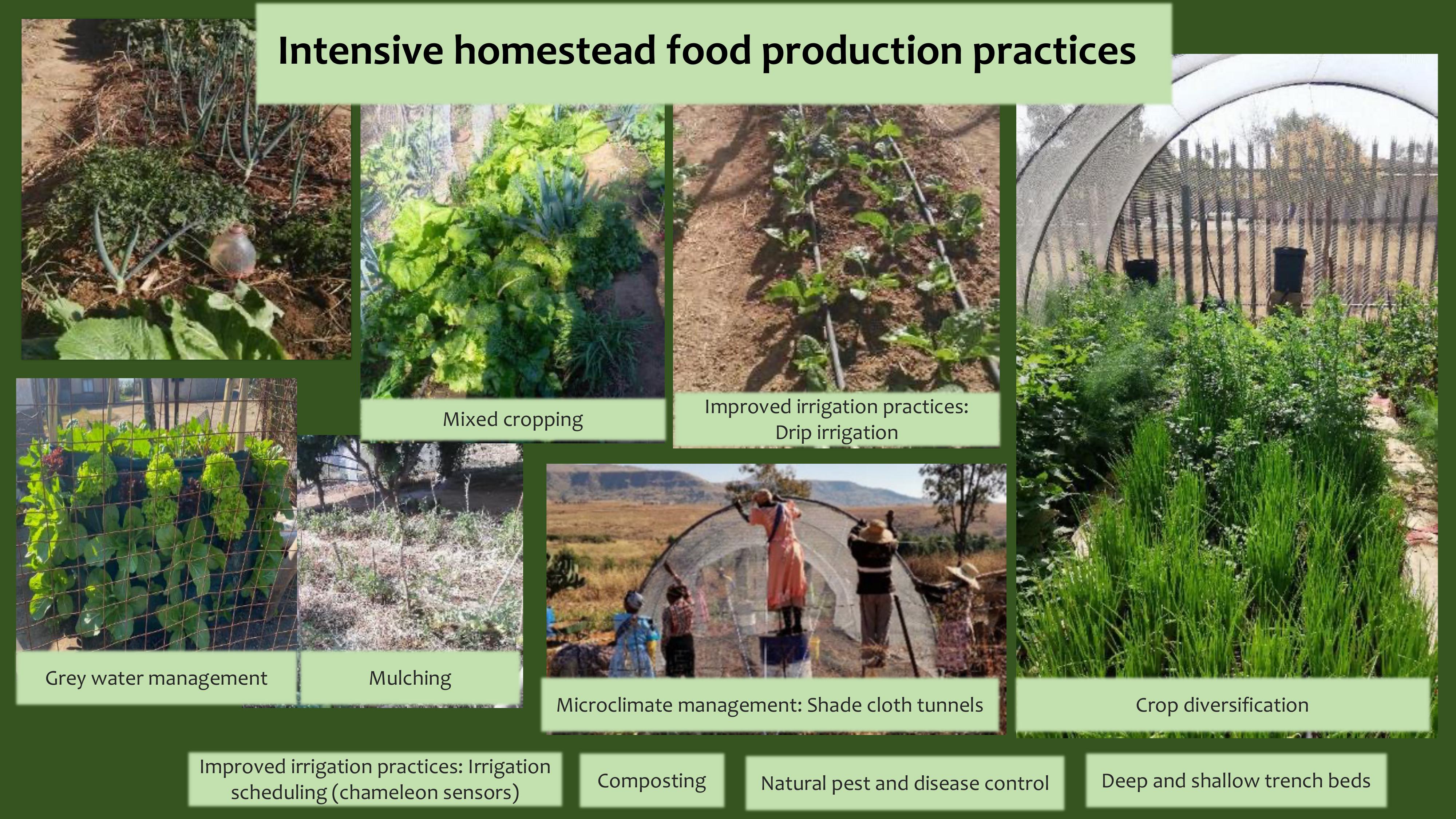
Improved irrigation practices: Irrigation
scheduling (chameleon sensors)Natural pest and disease control
Composting Deep and shallow trench beds
Grey water management
Microclimate management: Shade cloth tunnelsCrop diversification
Mulching
Improved irrigation practices:
Drip irrigation
Mixed cropping
Intensive homestead food production practices
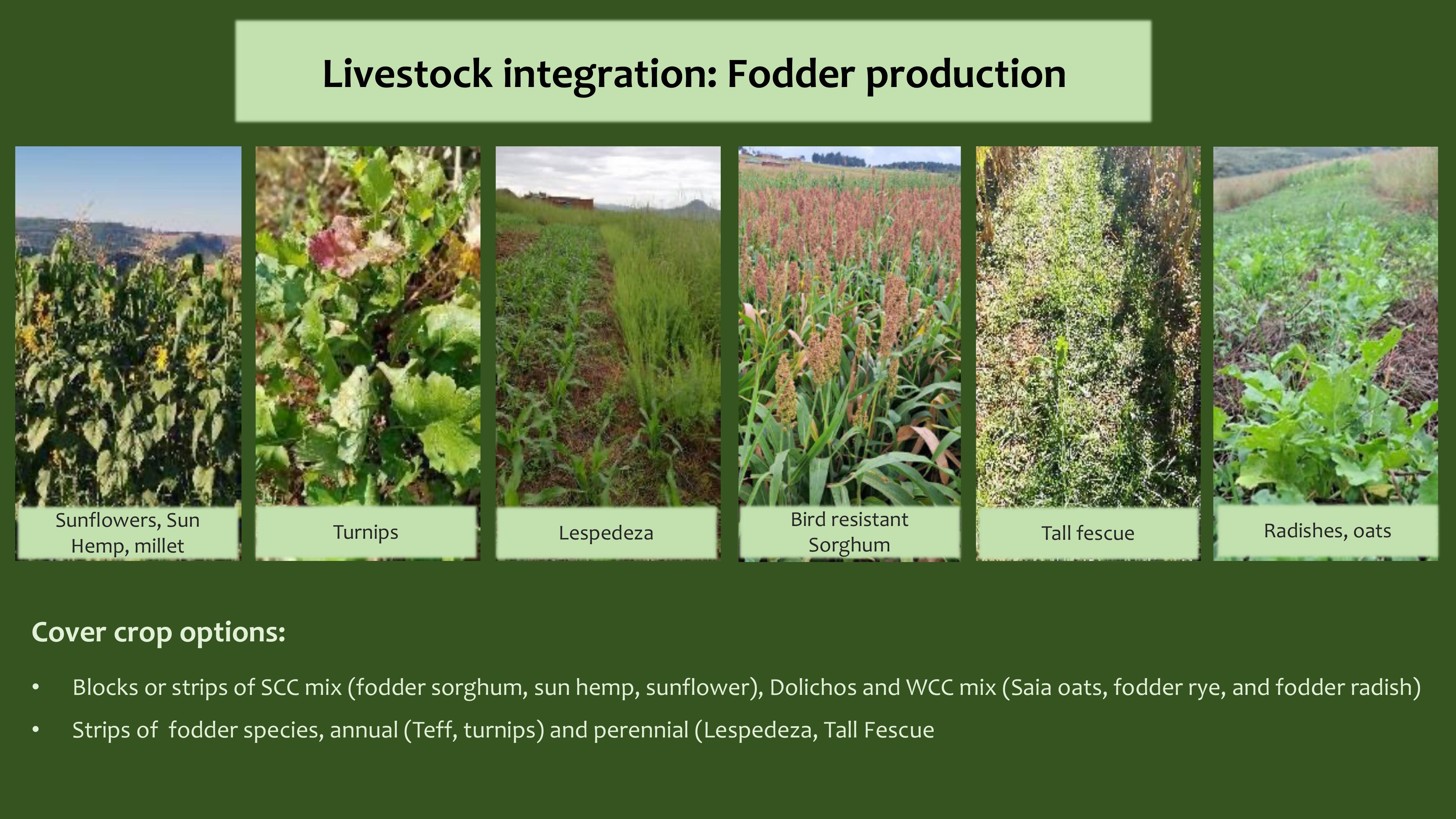
Livestock integration: Fodder production
Sunflowers, Sun
Hemp, milletTurnips Lespedeza Bird resistant
Sorghum TallfescueRadishes, oats
Cover crop options:
•Blocks or strips of SCC mix (fodder sorghum, sun hemp, sunflower), Dolichos and WCC mix (Saia oats, fodder rye, and fodder radish)
•Strips of fodder species, annual (Teff, turnips) and perennial (Lespedeza, Tall Fescue
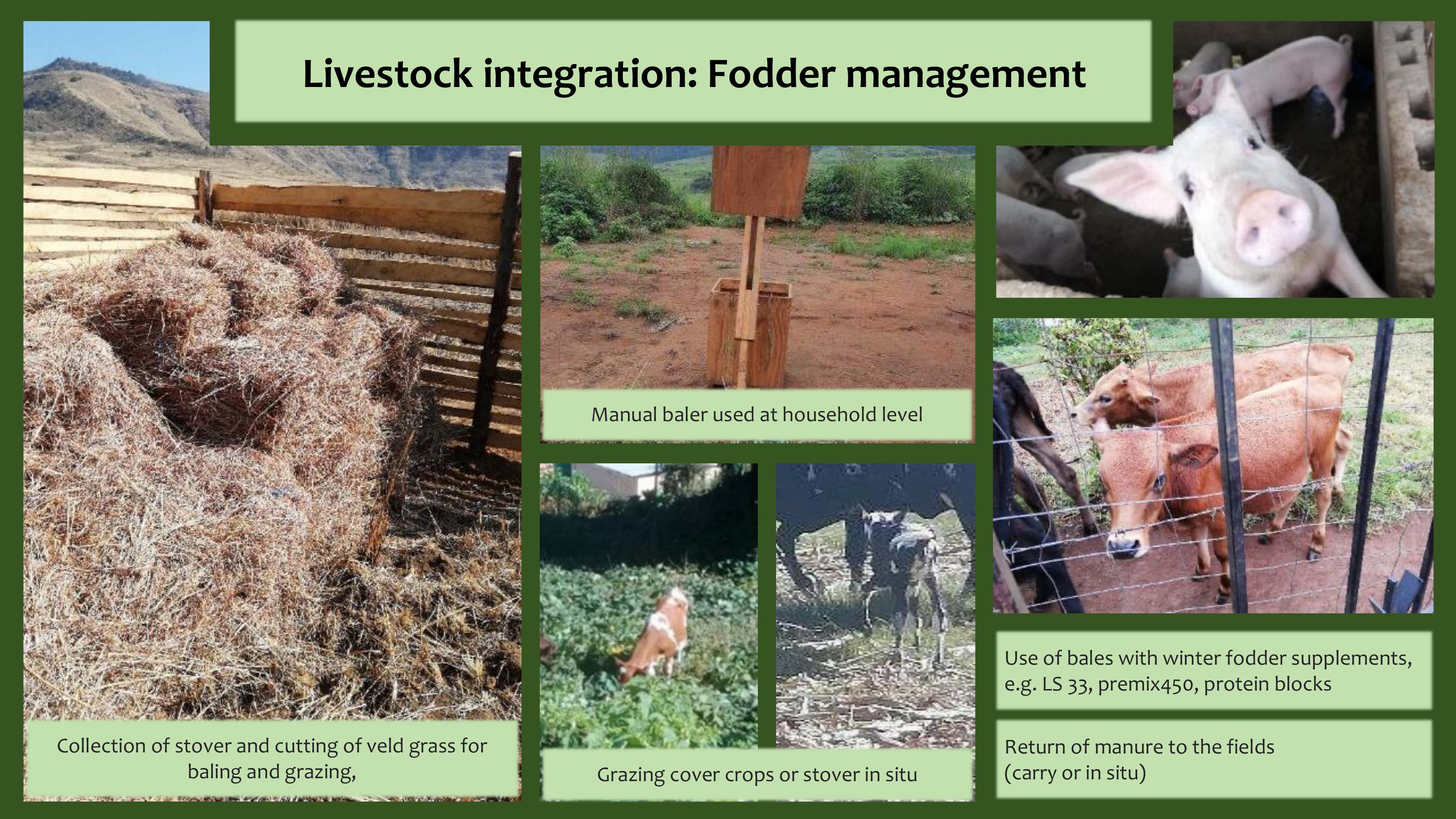
Livestock integration: Fodder management
Manual baler used at household level
Collection of stover and cutting of veld grass for
baling and grazing, Grazing cover crops or stover in situ
Return of manure to the fields
(carry or in situ)
Use of bales with winter fodder supplements,
e.g. LS 33, premix450, protein blocks
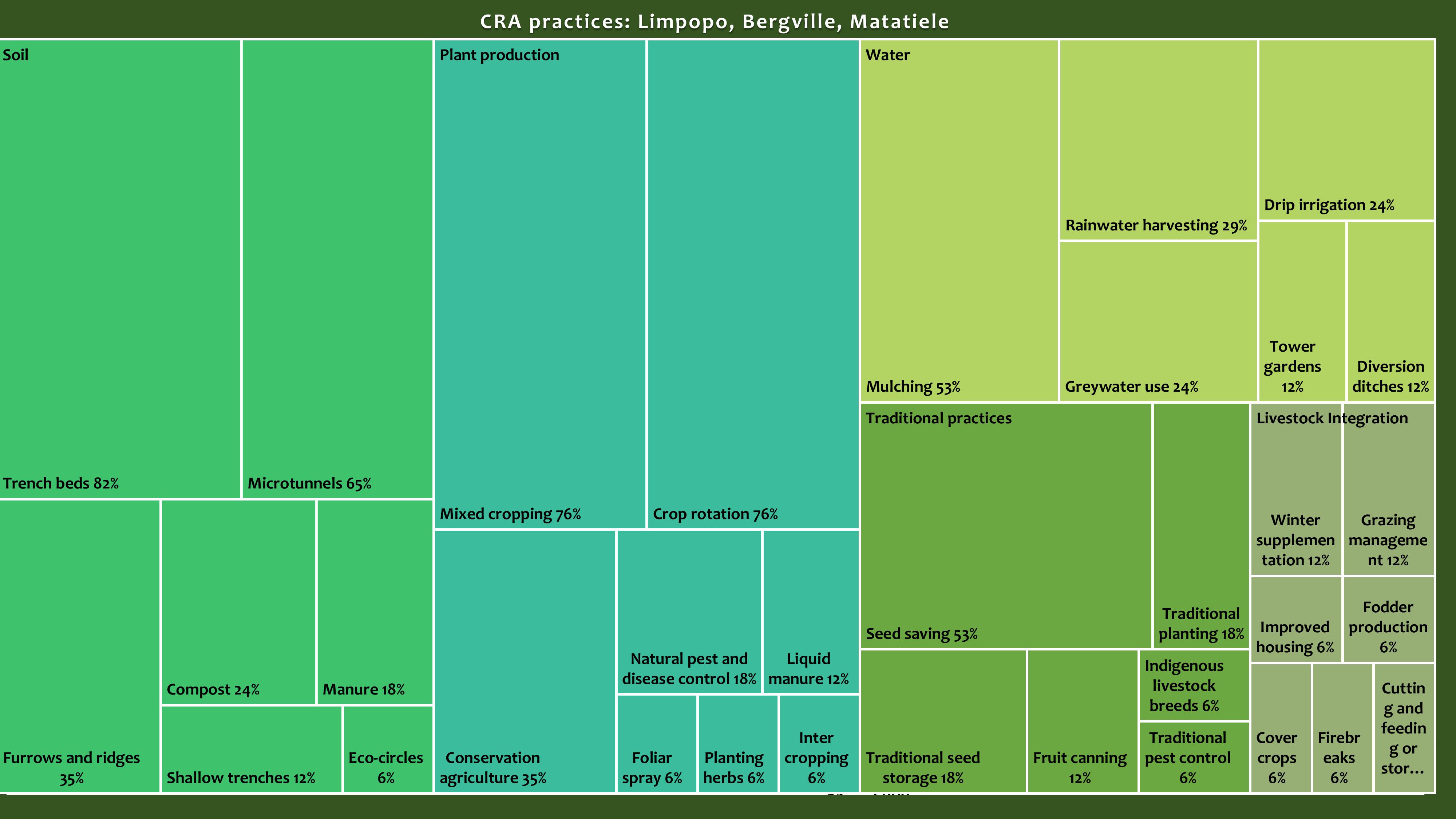
Soil
Trench beds, 95%Microtunnels, 90%
Shallow trenches,
25%
Eco-circles,
30%Furrows and ridges, 60%
Compost, 25%Manure, 75%
Raise
d
beds,
10%
Water
Tower
gardens, 15%
Rainwater harvesting, 90%
Un
der
gro
un
d
tan
k,
5%
Drip irrigation,
35%
Mulching, 60%
Diversion ditches,
20%
Stone bunds/lines, 75%
Plant production
Liquid manure, 45%
Foliar
spray,
5%
Conservation agriculture,
30%
Plantin
g
herbs,
5%
Natural pest
and disease
control, 15%
Mixed cropping, 85%
Inter cropping, 25%
Crop rotation, 90%
Seedli
ng
produ
ction,
Seed
propaga
tion, 10%
Traditional practices
Seed saving, 40%
Indigenous
livestock breeds,
20%
Banana basins,
25% Pruning, 5%
CRA practices: Limpopo, Bergville, Matatiele
Soil
Trench beds, 75%
Microtunnels, 60%
Furrows and
ridges, 10%
Compost, 15%
Manure, 80%
Water
Rain
water
har…
Drip irrigation, 55%
Mulching, 90%
Diversion ditches, 20%
Plant production
CA, 80%
Planti
ng
her…
Natural P&D control,
15%
Mixed cropping, 85%
Inter cropping, 70%
Crop rotation, 75%
Livestock Integration
Fodder production, 45%
Win
ter
sup
pl…
Grazing management,
20%
Fire breaks, 50%
Cutting, storage of
fodder, 50%
Cutting and Baling ,
40%
cutting and
feeding , 35%
Restoration, 35%
Traditional practices
Seed saving, 65%
Indige
nous
livesto
ck
breeds
, 10%
Trad …
Tradtional
planting,
15%
Traditional
seed
storage,
10%
Soil
Trench beds 82%
Microtunnels 65%
Shallow trenches 12%
Eco-circles
6%
Furrows and ridges
35%
Compost 24%
Manure 18%
Water
Tower
gardens
12%
Greywater use 24%
Rainwater harvesting 29%
Drip irrigation 24%
Mulching 53%
Diversion
ditches 12%
Plant production
Liquid
manure 12%
Foliar
spray 6%
Conservation
agriculture 35%
Planting
herbs 6%
Natural pest and
disease control 18%
Mixed cropping 76%
Inter
cropping
6%
Crop rotation 76%
Livestock Integration
Improved
housing 6%
Fodder
production
6%
Cover
crops
6%
Winter
supplemen
tation 12%
Grazing
manageme
nt 12%
Firebr
eaks
6%
Cuttin
g and
feedin
g or
stor…
Traditional practices
Seed saving 53%
Indigenous
livestock
breeds 6%
Traditional
pest control
6%
Fruit canning
12%
Traditional
planting 18%
Traditional seed
storage 18%

•29 VLSAs, 535 participants
•Combined monetary value of over R1 million
•Savings and small loans used for consumption
smoothing, debt repayments, ceremonies, food, home
improvements, small businesses and farming
•VSLAs are crucial for continued involvement in
farming and for more sustainable livelihoods
.
Village Saving and Loan Associations (VSLAs)~R255/
farmer/
month
saved
New innovation: Bulk
Loan Funds - larger
savings and longer
term for greater loan
potential– specifically
for production
0
5
10
15
20
25
30
35
Building
Education
Farming inputs
Household use
Production inputs
Small business inputs
Funeral purchases
Medical costs
Average % of farmers
Loans use categories and the average percentage of
farmers using loans in each
0
10
20
30
40
50
60
70
Education Food HouseholduseOther Production Small business
Average % of farmers
Savings use categories and the average percentage of
farmers saving in each
0
100
200
300
400
500
600
700
800
Rands per month
Average monthly amount saved perfarmer
before and now
Before
Now
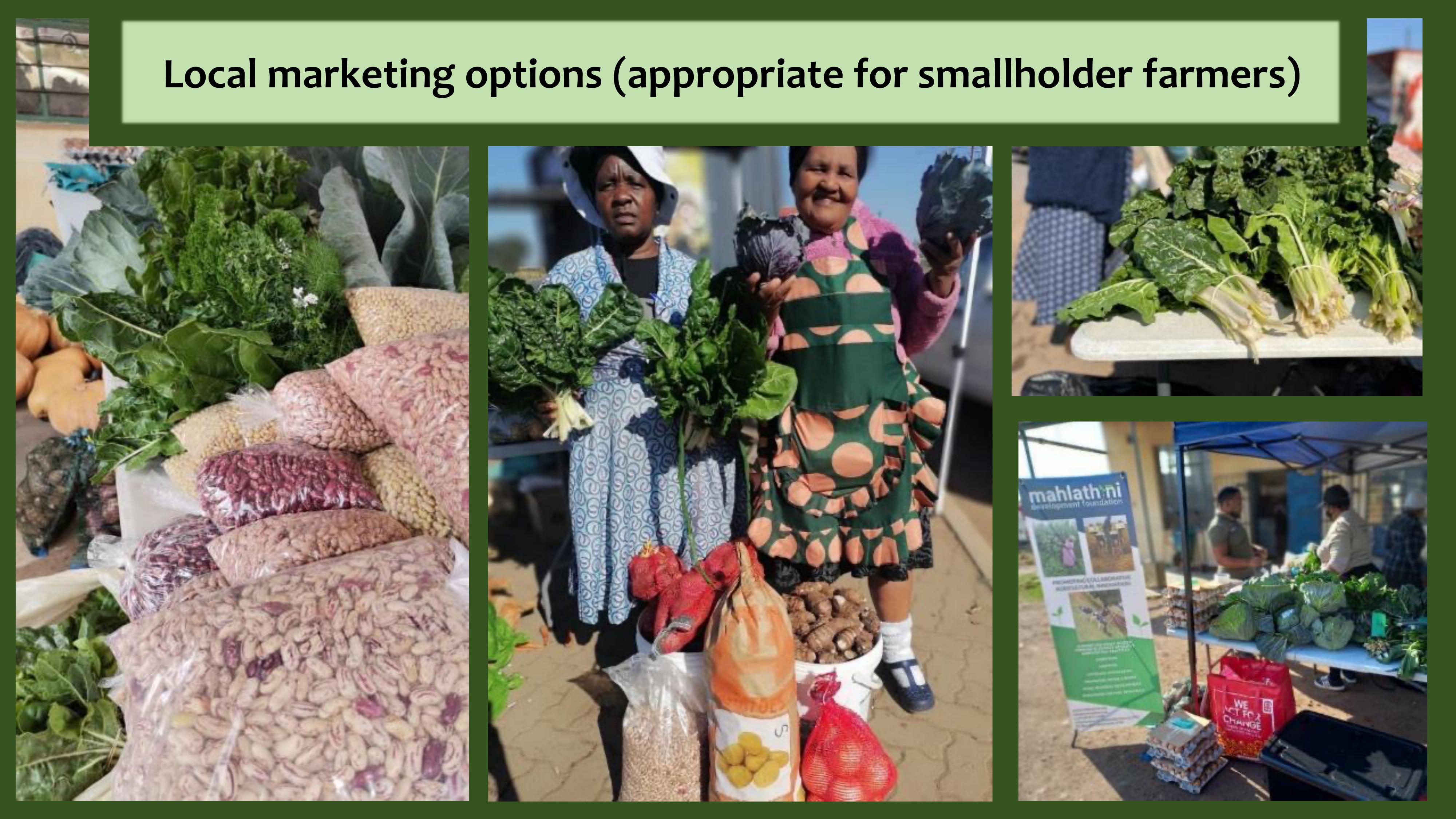
.
Local marketing options (appropriate for smallholder farmers)

•Local market stalls (combined across villages): much larger range of
products and income potential, also now focus on labelling,
branding, pricing, value adding and processing
•Bakkie traders, stores in local towns (individuals and groups within
villages): generally commodity focused, and farmers are price
takers – good for larger quantities but no competitive advantage
•Sale to local retailers and supermarkets (individuals): requires
transport, intermittent, price takers, little stability, competitive –
overalllow potential
•Food first, income from surplus (80% of
participants)
•Expansionof existing cropping areas and types
and number of crops grown (10-15%)
•Productionspecifically for sale (1-5%)
•Development of marketingoptions for
aggregating small quantities of a range of products
•Farmgate(within villages); small local potential
with low-income ceilings
Presently
the best
option

.
Farming activity
Average monthly income /participant
Annual income potential
Broilers
R1
025
R12
294
Layers (eggs)
R641
R7
692
Field crops:
Maize
Beans
R210
R238
R3
713
R2
850
Vegetables
R247
R2
964
All commodities
Average monthly value of
food/participant
Estimate based on interviews
R700
R8 400
Commodity for a selection of
participants only
Average monthly income/ participant
Annual income potential
Green Maize
R1
300
R15
600 to R24 000
Stall fed calves
R750
R9
000 to R50 000
Totalvalueofproduction(excl.
the selection)
R3
060
R36
713
Averaged from production
records. From further
individual interviews actual
averages Between R1 000-
R3 300.
More than doubled
production and incomes
over a 2 -year period.
Shows what is possible
but much broader
support required (more
people, more villages)
Improvement of livelihoods and incomes
2022
010000 20000 30000 40000
Total
Averagecurrent income
(R) R36268
Averageincreasein
income (R)R8440
Averageamount of
produce currently
produced (kg)
1258
Averageincreasein
amount of produce
produced (kg)
620
Averageproportion of
produce currently
consumed
68
Changes in elements of farming productivity
2024
0
10
20
30
40
50
60
70
80
90
Farming Other Remittances Small
business
Social grants
Average % of farmers
Livelihood diversity options (income sources) and the average
percentage of farmers deriving income from each before and
now
Before
Now

Provincial production and income trends
0500010000 15000 20000 25000 30000 35000 40000 45000 50000
Santeng
Sedawa
Turkey
Willows
Worcester
Santeng SedawaTurkey Willows Worcester
Average current income (R)R1153R24470R41659R46515R47292
Average increase in income (R)R 386R13443R12331R5263R4807
Average amount of producecurrently
produced(kg)6751431 2206649564
Average increase in amount of produce
produced(kg)115 4741355284 253
Average proportion ofproduce currently
consumed 75 59 62 73 76
Limpopo
02000 4000 6000 8000 100001200014000 16000 18000
Eqeleni
Ezibomvini
Stulwane
Vimbukhalo
EqeleniEzibomvini Stulwane Vimbukhalo
Average current income(R)R15 634R10 120R8 703R3 264
Average increase inincome (R)R9 505R9 448R2 845R2 206
Average amountofproduce
currently produced(kg)669 900 755 382
Average increase inamount of
produce produced(kg)273 565 259 196
Average proportionof produce
currently consumed70 52 67 75
Bergville
010000 20000 30000 40000 50000 60000
Nchodu
Ned
Nkau
Rhashule
NchoduNedNkau Rhashule
Average current income(R)R11 142R19 951R48 729R39 749
Average increase inincome (R)15521664 118910
Average amountofproduce
currently produced(kg)314 740 947 634
Average increase inamount of
produce produced(kg)222215 608 172
Average proportionof produce
currently consumed38 51 61 28
Matatiele

•Community owned local water access: Water committees,
spring protection, water reticulation, pipes and tanks at
homestead level
•Soil and water conservation: village-based learning groups
in Climate Change Adaptation undertake resource
conservation activities
ACTIVITY: Water and Natural Resource Management for sustainable and
productive use of land and water
48 villages in EC, KZN
and Limpopo
850 small holder
farmers
3500
beneficiaries
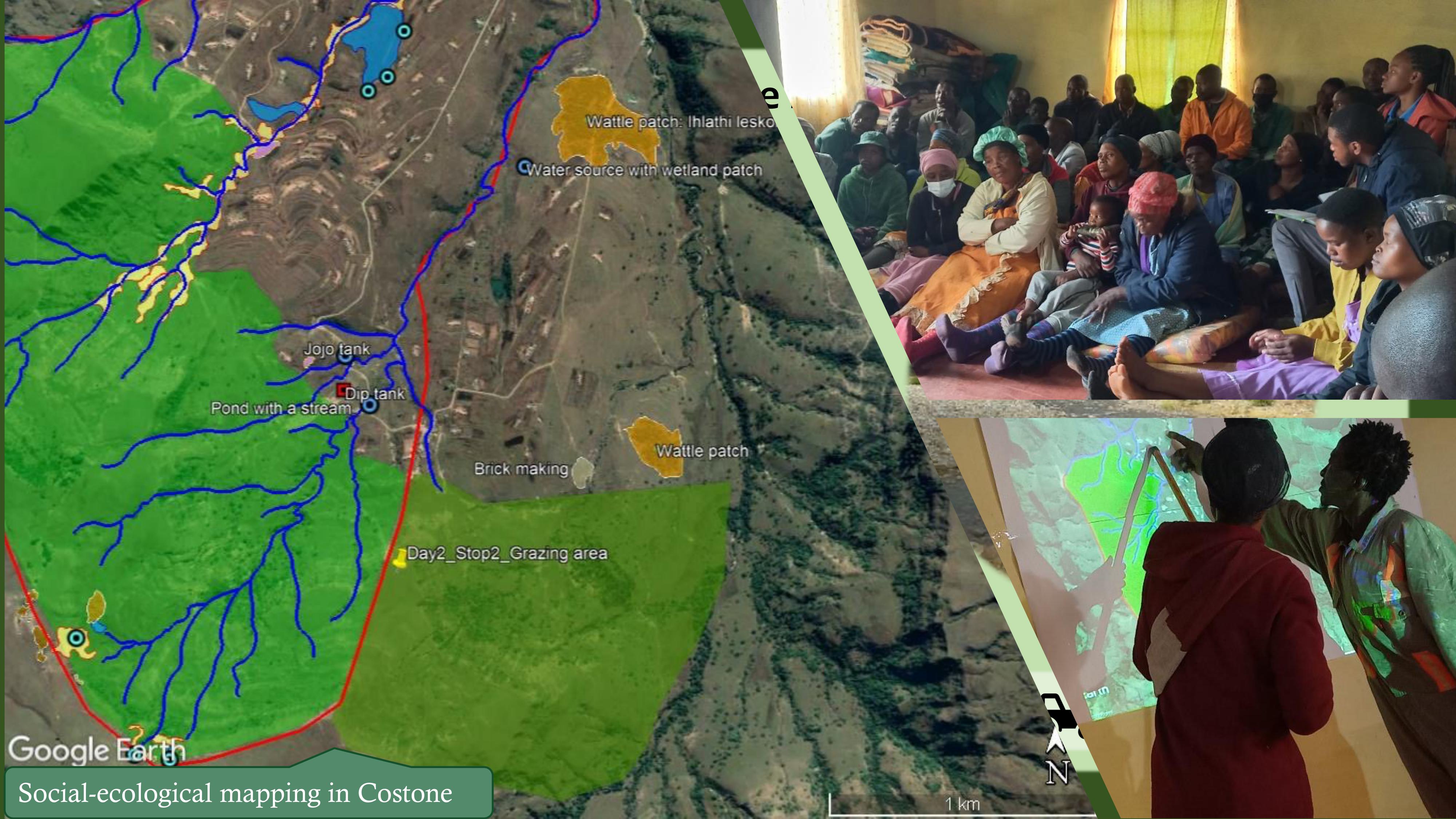
•Community owned local water access: Water committees,
spring protection, water reticulation, pipes and tanks at
homestead level
•Soil and water conservation: village-based learning groups
in Climate Change Adaptation undertake resource
conservation activities
•Social-ecological mapping and adaptive planning:for
community manged stewardship and resource conservation
efforts – including youth (as eco-champs)
ACTIVITY: Water and Natural Resource Management for sustainable and
productive use of land and water
48 villages in EC, KZN
and Limpopo
850 small holder
farmers
3500
beneficiaries
Social-ecological mapping in Costone

Local water access: Spring protection and boreholes

•Development of a water committee constitution
with rules of operation, membership criteria,
required contributions, etc
•Presently no legal option for providing such small
schemes with any recognition and support
(outside of a decree by the minister)
•WaterServiceAuthorities slowandunwilling to
recognize such options – but also not supporting
communities
Appropriate tech and low-cost options
•Springs secured and protected.
Reticulated header tanks with either
communal or household taps and tanks
•Watercommittees develop outofCRA
learning groups and include traditional
leadership
•These groups fully involved in assessing
options, planning and designing the
intervention, collection of monies ,
implementation, and maintenance
V-box
Header tanks
Communal tap
Digging offtake for
slotted pipe
Covering with bidem,
stones, and soil
Slotted pipeNatural spring
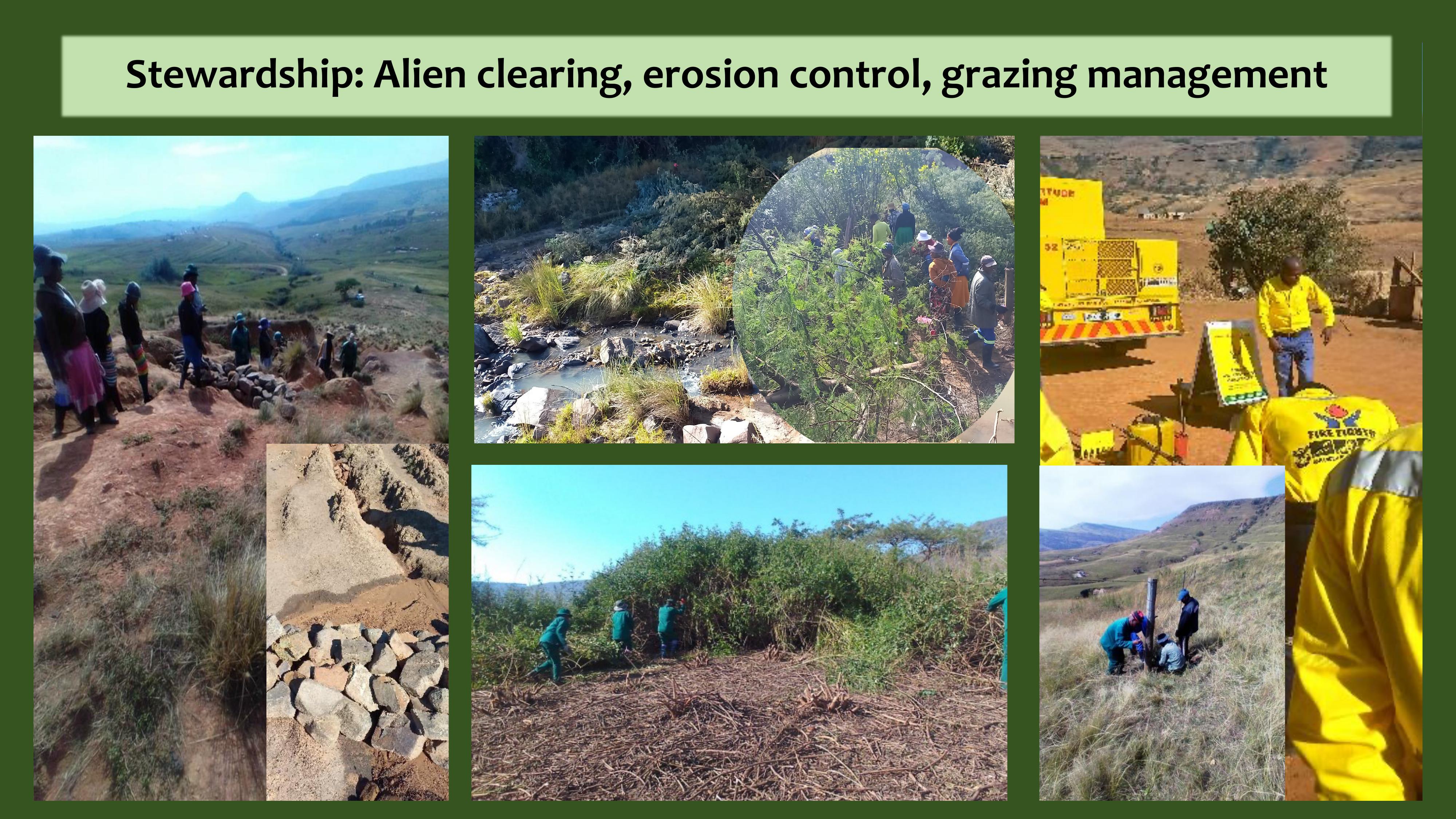
Stewardship: Alien clearing, erosion control, grazing management